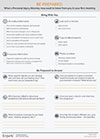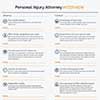Think these cases are cookie-cutter? Think again.
Rear-end accidents are the worst accidents you don't even see coming.
Many people think that because rear-end accidents presume automatic fault on the part of the other driver, they don't need a lawyer. To be fair, this is usually the case.
"Why should I split my settlement with an attorney when the ending's already written?" you think. The other driver was tailgating your car. They hit your car. You've been injured. The end.
Well, let's back up a few steps.
Were you completely spotless in this scenario?
Think long and hard about your driving and your car. When's the last time you had your vehicle checked out? Are your tail lights in working order? Remember, you usually don't know a tail light is out until someone tells you, since you can't see it. If you are driving a car that has faulty signals or a blown light, the driver behind you will not be held automatically liable.
This is also the case if you suddenly reverse or do something else unexpected. If you decide to stop in traffic when every natural inclination is to keep going, a judge would likely side with the other driver. If traffic came to a sudden halt and you had to stop, that would be taken into account.
Things would get complicated, however, if you realized, "Hey, my tire's gone flat," and stop in the middle of the road instead of pulling over. When you do something unexpected, the driver behind you can't read your mind.
That's what keeps the court system in business.
Where do you live?
The next question is whether you live in a fault or no-fault state. There are 12 no-fault states, and the idea there is that drivers are required to carry insurance – that way, if they get in an accident, they can just recover damages from their own policies rather than from the other driver and refrain from slowing down the court system with unnecessary lawsuits.
The injured drivers can sue for pain and suffering, but only if their injuries are exceptionally severe. Each state has a certain threshold, either verbal or monetary, that they have to meet. Instead those drivers usually rely on a PIP policy – which stands for personal injury protection.
In a fault state, everyone can sue anyone. An injured driver can sue the other driver personally or his insurance company, or both! Everyone pays according to each party's degree of fault in the accident.
How bad are your injuries?
If you got rear-ended, you might only have whiplash – or you might have a broken neck. Liability might be assumed for the driver who hit you, but his attorney is going to argue mitigating circumstances and that your injuries aren't as bad as they seem in an effort to lower damages.
The idea here is that even though liability is certain, there is a sliding scale of how much has to be paid out. Insurance adjustors have their own internal calculations for how bad an injury is, and you will have to illustrate exactly how injured you are. It's all well and good that you're in the right, but now you want your money. Are you capable of fighting to get it?

Damages worksheet to track expenses for your injury claim (medical treatment, property damage, lost wages, prescriptions)
Download in PDF format

Sample accident journal/diary to help you document the effect on your daily life
Download in PDF format
You're going to have to go against both the insurance adjustor and this attorney's years of expertise and knowledge of the law, and meanwhile, you have a broken neck.
It's best to have someone in your corner who knows what to do and who knows how to play the game. It is a game, really, and the other attorney knows how to play it better than you do. Why leave your settlement to chance? Part of a bigger settlement is better than all of a small settlement.
Is the other driver insured?
One of the worst things that can happen is when the other driver is uninsured. What are you going to collect against? If you're in a no-fault state, you can at least collect against your own policy. Many drivers even plan for this and have an uninsured motorist policy for this very eventuality. Some states require it.
But what if you don't?
The only other option is to sue the uninsured driver, which can turn out to be expensive and not worth your time. Generally the result is a payment plan of some small sum every week until the judgment is paid off. It might satisfy your sense of revenge to receive $60 a week, but after court fees, it might not be worth it.
Do you really want to do the work yourself?
Being a lawyer is hard. It takes three years of intense schooling that makes them go gray prematurely and turn to alcoholism at an impressive professional rate. They know where to look for every law and regulation, every rule and code of procedural conduct.
Do you really want to deal with that?
Some cases are fine to fly solo, like when only the car is damaged and you're just dealing with an insurance company. But when you have physical injuries to deal with and paperwork is piling up, the last thing you want to fight is the court system. It is a long and arduous process, and lawyers are the ones who know what to do and when to do it.
Represented plaintiffs get better settlements.
Lawyers can argue mitigating circumstances and that injuries are going to affect you later in life. They can show actuarial data you wouldn't even think of using. They are an important teammate for you to consider having, and they only win money when you do.

A worksheet to prepare for your first meeting with a personal injury attorney – what to bring, what they'll ask
Download in PDF format

Worksheet with questions to ask a personal injury attorney to help determine if he or she will be a good fit for your case
Download in PDF format
If you haven't found an attorney but are now thinking of using one, check out the Enjuris law firm directory and how to find the right car accident lawyer for you.
See our guide Choosing a personal injury attorney.

